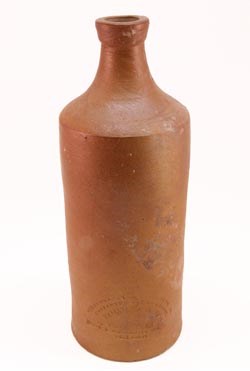Part of a series of articles titled Curious Collections of Fort Stanwix, The 19th & 20th Centuries.
Previous: Proverb Plate
Next: Phoenix Bitters Bottle
Article

NPS Image
Historically, many different kinds of goods were transported in bottles just like this. Ranging from ink, to medicine, to mineral water and even beer, stoneware bottles like this one appear in the archeological record as indicators of widespread trade and commercialism.
This particular bottle is from England, as can be seen from its "maker's mark." Maker's marks are important tools for archeologists because they can tell where, when, and by whom an object was made.
The maker's mark on this bottle is faint, but a partial transcription is as follows:
Vitreous Bottles
Warranted Not To Absorb
J. Bourne &Son
Patentees
Codnor Park Potteries
Near Derby

NPS Image
Archeologists use the information in the maker's mark to research the manufacturer and learn more about the path this bottle took from a pottery in England to upstate New York—probably on the Erie Canal!
This story begins with Joseph Bourne.
J. (Joseph) Bourne was an English ceramic entrepreneur, whose successful pottery operation in Denby, England grew to encompass many smaller potteries. Absorbing and consolidating these local operations led to what would become The Denby Pottery Company, which is still in existence today. Similarly, the "Codnor Park" Pottery from the transcription was one such pottery that eventually had their operation relocated to Denby.
This bottle has been identified as being "salt-glazed stoneware," the name stemming from the process where salt was added during the firing of the clay. Ceramics of this type were called "vitreous" because they retained the same qualities as glass and could store liquid materials safely. Glass was expensive to produce in large quantities in the 19th century, so ceramic vessels that could hold liquids were in demand until the early 1900s when glass production was mechanized.
There were probably thousands of these types of bottles that made their way to America, just like the one discovered during excavations at Fort Smith: Denby bottle at Fort Smith.
The Museum of London still holds two in their collection as well:
http://archive.museumoflondon.org.uk/ceramics/pages/object.asp?obj_id=490873
http://archive.museumoflondon.org.uk/ceramics/pages/object.asp?obj_id=490872
Read more about the past and present of ceramics from Denby at: Denby Heritage
Part of a series of articles titled Curious Collections of Fort Stanwix, The 19th & 20th Centuries.
Previous: Proverb Plate
Next: Phoenix Bitters Bottle
Last updated: October 6, 2022